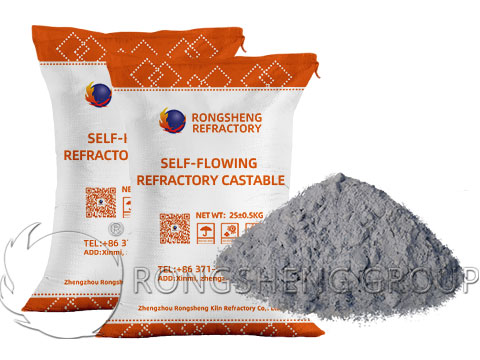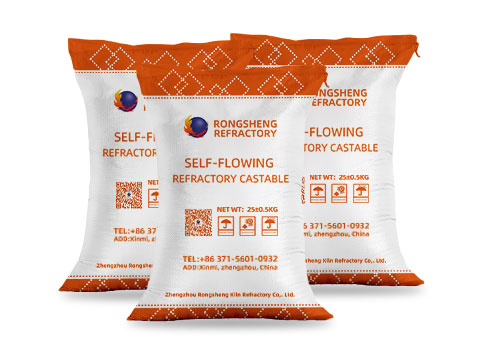The self-flowing refractory castable for heating furnaces is made of bauxite clinker as refractory aggregate, mixed with first-grade bauxite clinker and mullite aggregate. Refractory powder uses special-grade bauxite clinker powder, corundum powder, and mullite powder. At the same time, α-Al2O3 and SiO2 ultrafine powder and expansion agent are added, aluminate cement is used as the binding agent and a phosphate water-reducing agent is added.

Self-Flowing Refractory Castables for Heating Furnaces
The water consumption of self-flowing castables for heat furnaces is slightly higher than that of vibrating low-cement refractory castables of the same material. However, the performance of self-flowing refractory castables is still good, especially its high strength and small linear change after burning. This material is self-leveling and has good air exhaust because its particle gradation is reasonable and can achieve the tightest packing density. The binding agent, ultrafine powder, and water-reducing agent are reasonably selected and used in just the right amount, so they can overcome the defects caused by large amounts of water and improve their performance.
When the composition, mix ratio, and water consumption of self-flowing refractory castables for heating furnaces remain unchanged, adjust the addition amounts of the two to ensure that the combined amount is 7%. As the amount of uf-SiO2 increases, the flow value begins to increase sharply and then levels off. The flexural strength does not change much after burning, and there is an optimal value. After burning, the line change first increased from negative to positive and then shrank sharply. The dosage of uf-SiO2 is generally 3%~5%. That is, when the dosage of α-Al2O3 ultrafine powder is 4% to 2%, the flow value of the castable is ≥180mm, and the physical and mechanical properties are also good.
When configuring the self-flowing castable for the heating furnace, its composition materials and water consumption remain unchanged. When the cement consumption is increased, the fine powder consumption is correspondingly reduced. As the amount of CA-70 cement increases, the flow value of the castable decreases. The linear change after burning at 1450℃ changes from a positive value to a negative value, that is, from linear expansion to linear contraction. Because the amount of cement is large, the free water consumed during hydration increases. As a result, the viscosity of the castable increases, the flow value decreases, the density also decreases, and the linear change after burning changes from a positive value to a negative value. Then, the optimal dosage of cement is 2% to 6%, and the flow value and physical properties of the castable are the best.

Where are Self-Flowing Refractory Castables Generally Used?
With the development of modern industry, due to the fluidity of self-flowing refractory castables, self-flowing refractory castables are very suitable for use in parts with thin walls or complex shapes that cannot be vibrated for molding. At present, there are more and more applications of self-flowing refractory castables. Self-flowing refractory castable is a refractory material that can flow and degas without vibration.
Rongsheng refractory material manufacturer has an environmentally friendly, fully automatic unshaped refractory material production line. The characteristic of our self-flowing refractory castables is that they can be poured into various shapes of construction bodies without vibration by adding appropriate water without reducing or significantly reducing the performance of the castables. Generally used in construction sites with narrow and complex shapes. Such as the wrapping of water pipes at the bottom of steel rolling heating furnaces and the furnace walls of heating furnaces with special structures for heat storage. It is particularly convenient to use self-flowing refractory castables in certain areas that require local modification and filling.
This time let’s take the channel heating furnace as an example. There are many mutually isolated regenerators in the furnace body of the channel heating furnace, as well as many criss-crossing gas pipes or air pipes. It is very easy to cause problems when using traditional vibration molding castables to burn the mainstream. Due to the unreasonable gradation of ordinary refractory castables, it is prone to a series of reasons such as poor stability, reduced strength, and cracking.
Ordinary refractory castables use vibration equipment to make the castables flow during the construction process to achieve the required filling effect. However, vibration equipment cannot be used in a location with narrow space and complex shape such as the furnace wall of the regenerator (the furnace wall is a multi-layer structure, constructed in layers, and the thickness of each layer is about 100mm). This phenomenon can be avoided by using self-flowing refractory castables.
To purchase high-quality self-flowing refractory castables, please contact us. Get prices and samples for free.